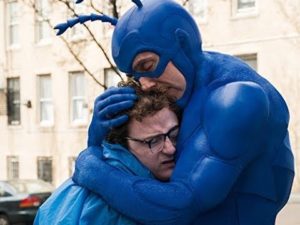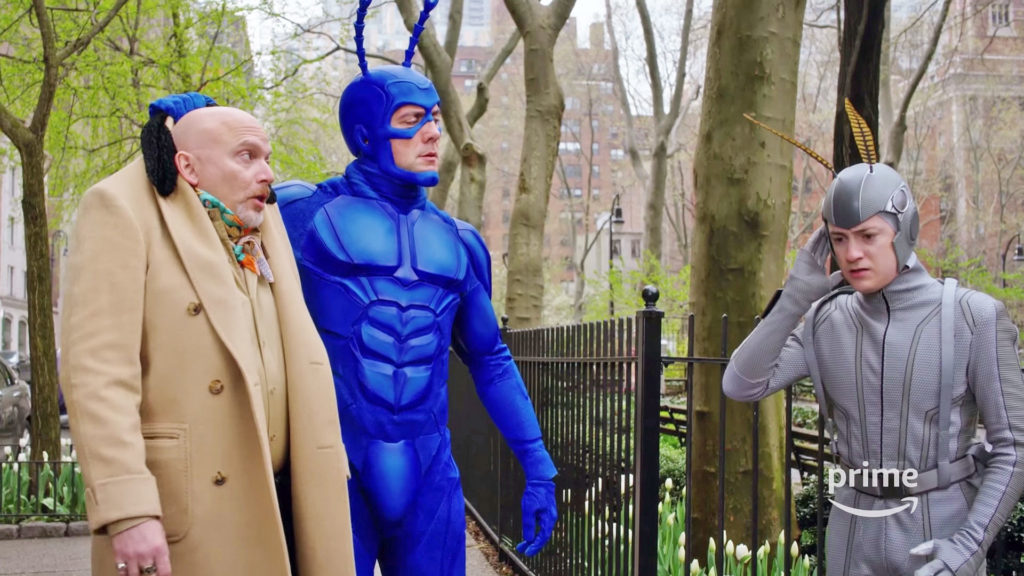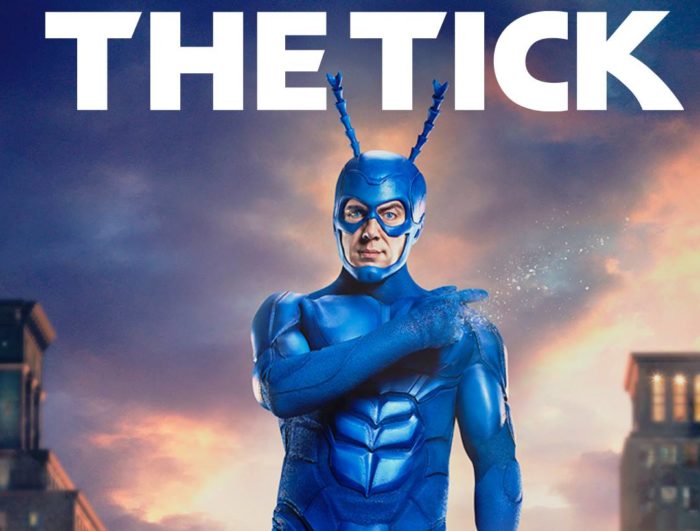Suddenly, ‘The Tick’ Bounds In and Brings Back Goodness
Goodness is a virtue that many modern heroes can’t afford. Darker heroes and anti-heroes have dotted the media landscape in recent years, and this has spilled into real life. Whether it’s in business, politics, the media, or even the church, you can see this “ends justify the means” morality playing out in a thousand different ways in our modern society.
Despite the darkness, people still gravitate towards fictional heroes that radiate goodness. However, work featuring these heroes often set them in a story world reminiscent of an older comic book, cartoon, Saturday morning serial. Darker situations require darker heroes. You wouldn’t drop a hero who represented unabashed goodness and decency into a world as gritty and dark as those inhabited by Marvel’s Netflix heroes.
 Yet that’s what Amazon Prime’s The Tick does. It takes the beloved comedy character from the 1980s comic and 1990s Cartoon series and drops him into the midst of a world full of foul-mouthed, violent thugs. If anything, The Tick (Peter Serafinowicz), is full of more buoyant goodness and decency than prior takes on the character, if for no reason other than The Tick’s world needs a lot more of it.
Yet that’s what Amazon Prime’s The Tick does. It takes the beloved comedy character from the 1980s comic and 1990s Cartoon series and drops him into the midst of a world full of foul-mouthed, violent thugs. If anything, The Tick (Peter Serafinowicz), is full of more buoyant goodness and decency than prior takes on the character, if for no reason other than The Tick’s world needs a lot more of it.
When The Tick came to “The City” (the only name given to the city The Tick is sworn to protect) in the 1994 animated series, he found it already teaming with zany heroes such as American Maid, the Human Bullet, Die Fledermaus, Sewer Urchin, and the Civic-Minded Five. When teamed with ex-accountant Arthur, the two formed an unbeatable crime-fighting duo.
In the same way, The Tick’s animated series arrived at a golden age for superhero series with Batman and Spider-Man leading the way. In terms of lighter takes on the superhero genre, there was already Darkwing Duck, and Freakazoid would be added to the mix in the The Tick’s final season on the air. The Tick was a memorable part of the 1990s cartoon scene, but with so many great and goofy shows around, it can only stand out so much.
In the Amazon Prime series, The Tick arrives to a City that’s haunted by a tragedy fifteen years before and Arthur Everest (Griffin Newman) was at the center of it. He grew up loving superheroes and his father, only to have the Terror drop a plane containing his favorite superheroes, the Flag Five, on top of his father. The trauma emotionally shatters Arthur, who struggles into adulthood with mental illness. The world believe the Terror was destroyed in a battle with Superian, but Arthur believes the Terror is still alive and pulling the strings of the City’s organized crime. Unfortunately, everyone attributes this belief to Arthur’s mental illness.
His sister Dot (Valerie Curry) responded to the tragedy by working to save lives, becoming a paramedic and going to medical school, while also trying to take care of her brother. Yet, the death of her father has left its mark as evidenced by her declaration that they’re just “collateral damage.”
It’s into the midst of this brokenness that The Tick comes bounding in. He takes a moth supersuit from the Pyramid gang and gives Arthur both the key to his destiny and a clue to the truth behind the Terror. He also unintentionally paints a big target on Arthur as the villains want the suit and will stop at nothing to get the suit back.
 The plot of this first season is about Arthur’s journey to becoming a hero. The show is so blatant about being based on the hero’s journey that The Tick references it aloud twice. Newman’s take on Arthur is weightier than the previous versions. There is still some comedy as he fumbles to understand how to use the suit and tries to find his way out of this mess, but we do see the tragedy, brokenness, and hidden strengths of the character as he embraces becoming who he always wanted to be. The mid-season finale, “Rising,” has Arthur taking a big step forward with one of the most epic scenes in Tick history.
The plot of this first season is about Arthur’s journey to becoming a hero. The show is so blatant about being based on the hero’s journey that The Tick references it aloud twice. Newman’s take on Arthur is weightier than the previous versions. There is still some comedy as he fumbles to understand how to use the suit and tries to find his way out of this mess, but we do see the tragedy, brokenness, and hidden strengths of the character as he embraces becoming who he always wanted to be. The mid-season finale, “Rising,” has Arthur taking a big step forward with one of the most epic scenes in Tick history.
The Tick is both the driving force of the story as well as its heart and moral center. This character is as zany and lovable as previous takes on the character, but also has a little bit more compassion and understanding of the human condition. Compare this to Patrick Warburton’s 2001 take on The Tick, who thought death was only something dead people had to worry about. In the latest take, with his new understanding, he arrives with no memory of his life prior to arriving in the City, but with an unshakable belief in Arthur and his theory that the Terror still lives.
He pushes Arthur along the road to destiny, offering endless encouragement even as Arthur’s fears have him ready to surrender the suit to the villains in hope of getting back to his normal life. The Tick also serves as a voice of moral righteousness when the murderous anti-hero Overkill (Scott Speiser) tries to tempt Arthur to adopt his methods. Tick tells Arthur, “Murder—it’s just not cool,” and warns him that Overkill “wants to make a murder salad out of your hero’s journey.”

This new take on The Tick may be an enemy to evil and to anti-heroes, but he’s a friend to anyone else. He makes friends with Arthur’s neighbors and lets a homeless man use Arthur’s shower. He’s a delightful guest at Arthur’s stepfather’s birthday party, which I couldn’t imagine the animated Tick being. Even when The Tick says or does things he’s done in previous series, it has a different feel. For example, when The Tick told Arthur in the animated series, “You’re not going crazy, you’re going sane in a crazy world,” it just felt like a goofy line. But in 2017 and in the world of the new Tick series, it feels surprisingly on point.
The rest of the supporting characters are well written and improved from previous takes. Dot shows a lot of interesting and nuanced character with plenty of reasons for her initial reluctance to keep Arthur out of the hero games. She undergoes her own mini-arch during the first few episodes as she has to decide how to handle the new developments in her brother’s life.
The villainous Terror (Jackie Earle Haley) is the most evil person with a murderous career that goes back decades. Haley’s performance is solid, he manages to convey the type of menace that would traumatize someone for decades, while in other scenes showing the sociopathic charm we’ve come to expect from big villains. Miss Lint (Yara Martinez) is more nuanced. She and her powers project real menace, but they also lend themselves to comedy given her tendency to constantly attract lint. In addition, she’s clearly in a bit of a funk, as she has to have her ex-husband as her roommate. When the Terror tells her in a complimentary way that she’s “pure evil,” I don’t quite buy it. Ramses IV, an Egyptian-themed villain from Minnesota who wears eyeliner, rounds out the villains. He’s pathetic with a total lack of competence that provides cheap laughs. But we learn in “Rising,” that there’s a reason such a weak villain is in charge of the biggest gang in the City.
Overkill is your typical gun-toting anti-hero, but there are some interesting hints about his past as well as a potential past relationship with Miss Lint. The best thing going for Overkill is that he has a sarcastic talking boat (voiced by Alan Tudyk) as his headquarters and sidekick.
The series is not without its faults. There’s an ever growing, naked man about the size of Godzilla innocently roaming the countryside for some reason.1 No doubt he’ll feature in the second half of the season, and teasing that for a few seconds wouldn’t have been a bad idea, but it’s teased in several episodes including an extended scene in the sixth episode. It’s pointless padding at this point in the series.
In addition, despite the series’ positive messages, parents should use discretion. The series stretches its TV-14 rating to the limit with a couple of quick scenes of graphic violence as well as some strong obscenities including a smattering of F-bombs. If you’re okay with your kids watching Daredevil then this is fine. If not, discretion and discernment is advised.
In an interview with the Fan Carpet Extra, Serafinowicz, who is also one of the show’s producers, expressed hope that Amazon would release an edited version (without the language) that kids could watch. This could be done fairly easily and without losing the show’s edge as the most objectionable moments are brief and not essential to plot or tone.
Still, even with its problematic elements, the first half of The Tick offers a good, enjoyable series with great lead characters and an engaging storyline. Most importantly all, it suggests goodness is the key to overcoming evil. Here’s hoping that tone and message stand firm when the second half of the season is released next year.
- Editor’s note: the poor confused man’s personal region is pixelated, but otherwise you see a lot. ↩






































Thanks for this review. My limited glimpses of The Tick made me think it was too cheesy and dopey to be worth my time (I’m not much for comedies normally). Based on what you say here, though, it might be worth a deeper look.